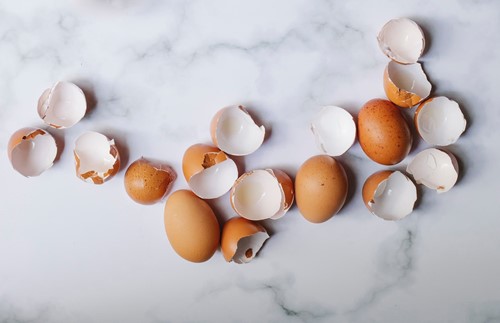
We often use dried eggshells as fertilizer in outdoor gardens. Their extremely high calcium content makes them an excellent way to add extra nutrients to the soil. When properly prepared, eggshells can make for great indoor plant fertilizer as well. Here we’ll go over how to use this common food waste to nourish your houseplants in 5 steps.
Before setting them aside, make sure you rinse the eggshells carefully in cold or room temperature water. This will break down the proteins left behind from the raw egg to leave a clean inside surface. This will prevent any chance of bacteria or mold developing and causing odor.
Let the eggshells dry out entirely before moving on. If you don’t want to wait, you can place them on a baking sheet in a warm oven or toaster oven. The most efficient method is to put them into the oven as it cools after baking a meal. Once the shells are completely dry they are ready for the next step.
In a large bowl or other container, pulverize the shells into small pieces using wooden spoons, potato mashers or any other blunt tool from around the kitchen. Be careful not to send pieces flying—it’s best to use a bigger bowl than you think you need. Once the eggs are in small pieces, either transfer to a food processor or use a mortar and pestle to grind them up into a fine powder. While it doesn’t have to be perfect, you’ll get better results from a fine, mostly uniform grain.
Once you have your eggshell powder, you have two options for how to give it to your plants. One method is to mix or sprinkle it in to the potting soil. The other is to make what some gardeners call “eggshell tea” by mixing the powder with boiling water and letting it sit for 24 hours. This will give you a liquid form of fertilizer that you can carefully distribute among your houseplants by pouring directly into the soil. Note that the “strength” of the fertilizer will depend on the number of eggshells you used. A common recipe suggestion is 10 to 20 eggshells per one gallon of water.
Eggshells, even when crushed and boiled, take a long time to decompose. You will not see results from this type of fertilizer overnight, but the extra calcium and potassium boost from the eggshells will help to nourish your house plants over the long term. Some gardeners recommend adding fertilizer before or during a plant’s growing season to help strengthen new growth. Depending on the plant, you may not need more than one “feeding.” Always research your specific plants’ needs and growing cycles to determine the best possible time to fertilize them.
This is a great way to re-use your old eggshells rather than throw them away. You can feed your plants while avoiding adding more slow-decomposing material to landfills. Your plants will thank you, too.
